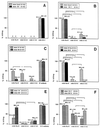Binding to and opsonophagocytic activity of O-antigen-specific monoclonal antibodies against encapsulated and nonencapsulated Klebsiella pneumoniae serotype O1 strains
- PMID: 10768923
- PMCID: PMC97438
- DOI: 10.1128/IAI.68.5.2402-2409.2000
Binding to and opsonophagocytic activity of O-antigen-specific monoclonal antibodies against encapsulated and nonencapsulated Klebsiella pneumoniae serotype O1 strains
Abstract
The high mortality of nosocomial infections caused by Klebsiella spp. has acted as a stimulus to develop immunotherapeutic approaches targeted against surface molecules of these bacteria. Since O-antigen-specific antibodies may add to the protective effect of K antisera, we tested the functional and binding capacity of O-antigen-specific monoclonal antibodies (MAbs) raised against different Klebsiella O antigens. The MAbs tested were specific for the O-polysaccharide partial antigens D-galactan II (MAb Ru-O1), D-galactan I (MAb IV/4-5), or core oligosaccharide (MAb V/9-5) of the Klebsiella serogroup O1 antigen. In enzyme-linked immunosorbent assay binding experiments, we found that all MAbs recognized their epitopes on intact capsule-free bacteria; however, binding to encapsulated wild-type strains belonging to different K-antigen serotypes was significantly reduced. The K2 antigen acted as the strongest penetration barrier, while the K7 and K21 antigens allowed some, though diminished, antibody binding. In vitro phagocytic killing experiments showed that MAb Ru-O1 possessed significant opsonizing activity for nonencapsulated O1 serogroup strains and also, to a much lesser extent, for encapsulated strains belonging to the O1:K7 and O1:K21 serotypes. MAbs or antisera specific for the D-galactan II antigen may thus be the most promising agents for further efforts to develop a second-generation Klebsiella hyperimmune globulin comprising both K- and O-antigen specificities.
Figures


Similar articles
-
Protective effect of antilipopolysaccharide monoclonal antibody in experimental Klebsiella infection.Infect Immun. 1997 May;65(5):1754-60. doi: 10.1128/iai.65.5.1754-1760.1997. Infect Immun. 1997. PMID: 9125558 Free PMC article.
-
O antigen seroepidemiology of Klebsiella clinical isolates and implications for immunoprophylaxis of Klebsiella infections.Vaccine. 2004 Feb 17;22(7):818-21. doi: 10.1016/j.vaccine.2003.11.026. Vaccine. 2004. PMID: 15040933
-
Surface antigen exposure by bismuth dimercaprol suppression of Klebsiella pneumoniae capsular polysaccharide.Infect Immun. 1999 Feb;67(2):664-9. doi: 10.1128/IAI.67.2.664-669.1999. Infect Immun. 1999. PMID: 9916074 Free PMC article.
-
O-antigen seroepidemiology of Klebsiella clinical isolates and implications for immunoprophylaxis of Klebsiella infections.Clin Diagn Lab Immunol. 1997 Sep;4(5):550-5. doi: 10.1128/cdli.4.5.550-555.1997. Clin Diagn Lab Immunol. 1997. PMID: 9302204 Free PMC article.
-
Klebsiella pneumoniae Lipopolysaccharide as a Vaccine Target and the Role of Antibodies in Protection from Disease.Vaccines (Basel). 2024 Oct 17;12(10):1177. doi: 10.3390/vaccines12101177. Vaccines (Basel). 2024. PMID: 39460343 Free PMC article. Review.
Cited by
-
Capsular polysaccharide inhibits vaccine-induced O-antigen antibody binding and function across both classical and hypervirulent K2:O1 strains of Klebsiella pneumoniae.PLoS Pathog. 2023 May 5;19(5):e1011367. doi: 10.1371/journal.ppat.1011367. eCollection 2023 May. PLoS Pathog. 2023. PMID: 37146068 Free PMC article.
-
O-antigen polysaccharides in Klebsiella pneumoniae: structures and molecular basis for antigenic diversity.Microbiol Mol Biol Rev. 2025 Jun 25;89(2):e0009023. doi: 10.1128/mmbr.00090-23. Epub 2025 Mar 21. Microbiol Mol Biol Rev. 2025. PMID: 40116577 Review.
-
Role of neutrophils in response to Bordetella pertussis infection in mice.Infect Immun. 2009 Mar;77(3):1182-8. doi: 10.1128/IAI.01150-08. Epub 2008 Dec 22. Infect Immun. 2009. PMID: 19103765 Free PMC article.
-
Discovery of monoclonal antibodies cross-reactive to novel subserotypes of K. pneumoniae O3.Sci Rep. 2017 Jul 26;7(1):6635. doi: 10.1038/s41598-017-06682-2. Sci Rep. 2017. PMID: 28747785 Free PMC article.
-
The characterization of Klebsiella pneumoniae associated with neonatal sepsis in low- and middle-income countries to inform vaccine design.Commun Biol. 2025 Jun 9;8(1):898. doi: 10.1038/s42003-025-08258-7. Commun Biol. 2025. PMID: 40490475 Free PMC article.
References
-
- Bartlett J G, O'Keefe P, Tally F P, Louie T J, Gorbach S L. Bacteriology of hospital-acquired pneumonia. Arch Intern Med. 1986;146:868–871. - PubMed
-
- Blumenkrantz N, Asboe-Hansen G. New method for quantitative determination of uronic acids. Anal Biochem. 1973;54:484–489. - PubMed
-
- Carpenter J L. Klebsiella pulmonary infections: occurrence at one medical center and review. Rev Infect Dis. 1990;12:672–682. - PubMed
-
- Cross A S. Antiendotoxin antibodies: a dead end? Ann Intern Med. 1994;121:58–60. - PubMed
-
- Cross A S, Lowell G H, Palmblad J, Sadoff J C, Young L, Berger M. Mechanism of priming of human neutrophils by a soluble lymphoblastoid cell factor. J Immunol. 1985;135:2074–2083. - PubMed
MeSH terms
Substances
LinkOut - more resources
Full Text Sources
Other Literature Sources
Research Materials
Miscellaneous

